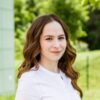How Fashion Tagging Works and Changes E-Commerce?
An in-depth overview of the key AI tools reshaping the fashion industry, with a focus on automated fashion tagging.

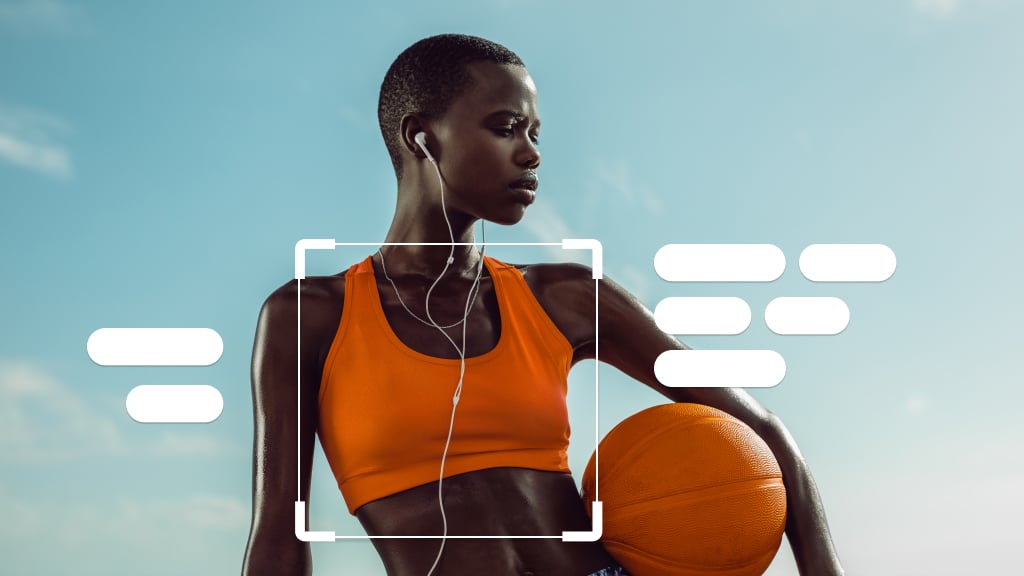
Keeping up with the constantly emerging trends is essential in the fashion industry. Beyond shifts in cuts, materials, and colours, staying updated on technological trends has become equally, if not more, crucial in recent years. Given our expertise in Fashion AI, let’s take a look at the key technologies reshaping the world of fashion e-commerce, with a particular focus on a key Fashion AI tool: automated fashion tagging.
AI’s Impact on Fashion: Turning the Industry on Its Head
The latest buzz in the fashion e-commerce realm revolves around visual AI. From AI-powered fashion design to AI-generated fashion models, and all the new AI tools, which rapidly change our shopping experience by quietly fueling the product discovery engines in the background, often unnoticed.
Key AI-Powered Technologies in Fashion E-Commerce
So what are the main AI technologies shaking up fashion e-commerce lately? And why is it important to keep up with them?
Recognition, Detection & Data Enrichment in Fashion
In the world of fashion e-commerce, time is money. Machine learning techniques now allow fashion e-shops to upload large unstructured collections of images and extract all the necessary information from them within milliseconds. The results of fashion image recognition (tags/keywords) serve various purposes like product sorting, filtering, searching, and also text generation.

These tools are indispensable for today’s fashion shops and marketplaces, particularly those with extensive stock inventories and large volumes of data. In the past few years, automated fashion tagging has made time-consuming manual product tagging practically obsolete.
Generative AI Systems for Fashion
The fashion world has embraced generative artificial intelligence almost immediately. Utilizing advanced AI algorithms and deep learning, AI can analyze images to extract visual attributes such as styles, colours, and textures, which are then used to generate visually stunning designs and written content. This offers endless possibilities for creating personalized shopping experiences for consumers.
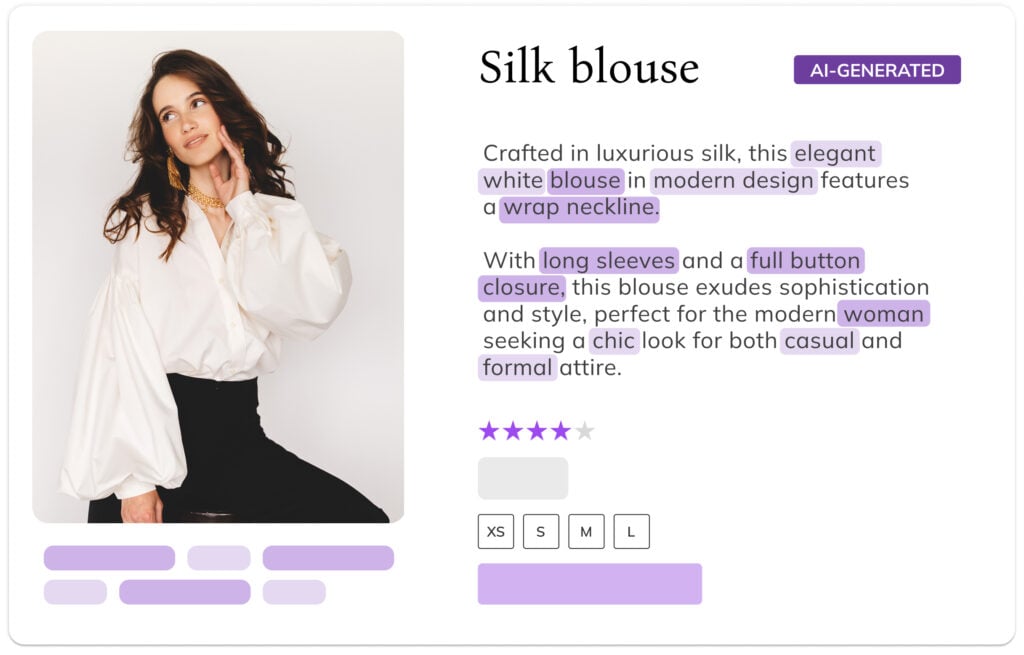
Our AI also enables you to automate the writing of all product titles and product descriptions via API, directly utilizing the product attributes extracted with deep tagging and letting you select the tone, length, and other rules to get SEO-friendly texts quickly. We’ll delve deeper into this later on.
Fashion Discovery Engines and Recommendation Systems
Fashion search engines and personalized recommendations are game-changers in online shopping. They are powered by our speciality: visual search. This technology analyzes images in depth to capture their essence and search vast product catalogs for identical or similar products. Three of its endless uses are indispensable for fashion e-commerce: similar items recommendations, reverse image search and image matching.
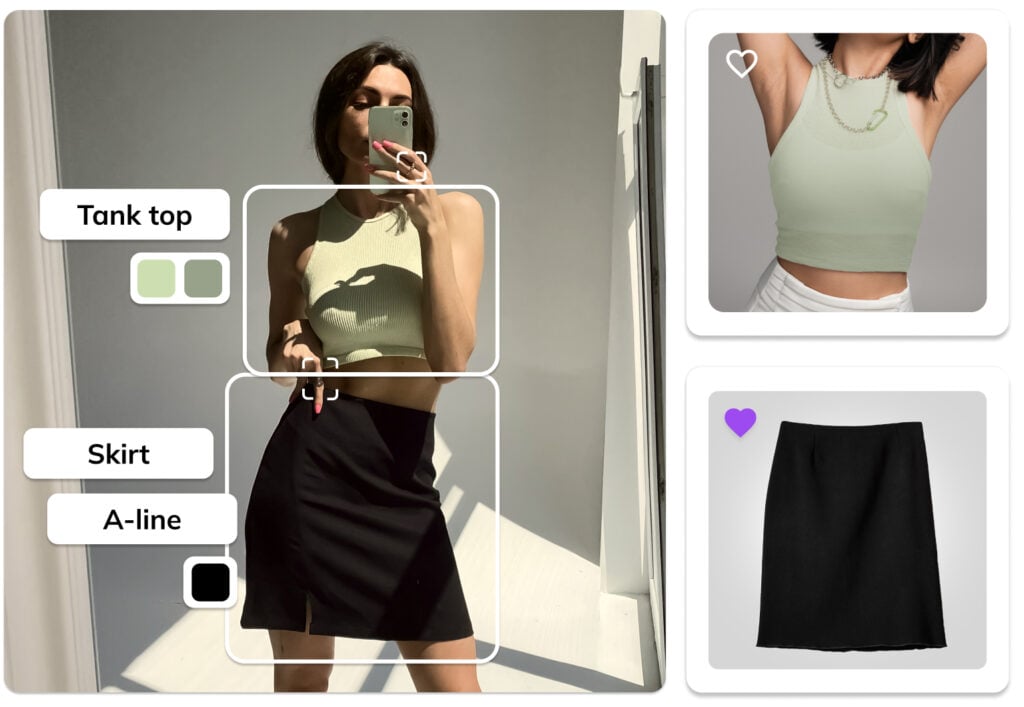
Visual search enables shoppers to effortlessly explore new styles, find matching pieces, and stay updated on trends. It allows you to have your own visual search engine, that rapidly scans image databases with millions of images to provide relevant and accurate search results within milliseconds. This not only saves you time but also ensures that every purchase feels personalized.
Shopping Assistants in Fashion E-Commerce and Retail
The AI-driven assistants guide shoppers towards personalized outfit choices suited for any occasion. Augmented Reality (AR) technology allows shoppers to virtually try on garments before making a purchase, ensuring their satisfaction with every selection. Personalized styling advice and virtual try-ons powered by artificial intelligence are among the hottest trends developed for fashion retailers and fashion apps right now.
Both fashion tags for occasions extracted with our automated product tagging, as well as similar item recommendations, are valuable in systems that assist customers in dressing appropriately for specific events.
My Fashion Website Needs AI Automation, What Should I Do?
Consider the Needs of Your Shoppers
To provide the best customer experience possible, always take into account your shoppers’ demographics, geographical location, language preferences, and individual styles.
However, predicting style is not an easy task. But by utilizing AI, you can analyze various factors such as user preferences, personal style, favoured fashion brands, liked items, items in their shopping baskets, and past purchases. Think about how to help them discover items aligned with their preferences and receive only relevant suggestions that inspire rather than overwhelm them.
There are endless ways to improve a fashion e-shop. Always keep in mind not to overwhelm the visitors, and streamline your offer to the most relevant items.
While certain customer preferences can be manually set up by users when logging into an app or visiting an e-commerce site, such as preferred sizes, materials, or price range, others can be predicted. For example, design preferences can be inferred based on similarities with items visitors have browsed, liked, saved, or purchased.
Three Simple Steps to Elevate Your Fashion Website With AI
Whether you run a fashion or accessories e-shop, or a vintage fashion marketplace, using these essential AI-driven features could boost your traffic, improve customer engagement, and get you ahead of the competition.
Automate Product Tagging & Text Generation
The image tagging process is fueled by specialised object detection and image recognition models, ensuring consistent and accurate tagging, without the need for any additional information. Our AI can analyze product images, identify all fashion items, and then categorize and assign relevant tags to each item individually.
In essence, you input an unstructured collection of fashion images and receive structured metadata, which you can immediately use for searching, sorting, filtering, and product discovery on your fashion website.

The keywords extracted by AI can serve right away to generate captivating product titles and descriptions using a language model. With Ximilar, you can pre-set the tone and length, and even set basic rules for AI-generated texts tailored for your website. This automates the entire product listing process on your website through a single API integration.
Streamline and Automate Collection Management With AI
Visual AI is great for inventory management and product gallery assembling. It can recognize and match products irrespective of lighting, format, or resolution. This enables consistent image selection for product listings and galleries.
You can synchronise your entire fashion apparel inventory via API to ensure continual processing by up-to-date visual AI. You can either set the frequency of synchronization (e.g., the first day of each month) or schedule the synchronization run every time you add a new addition to the collection.
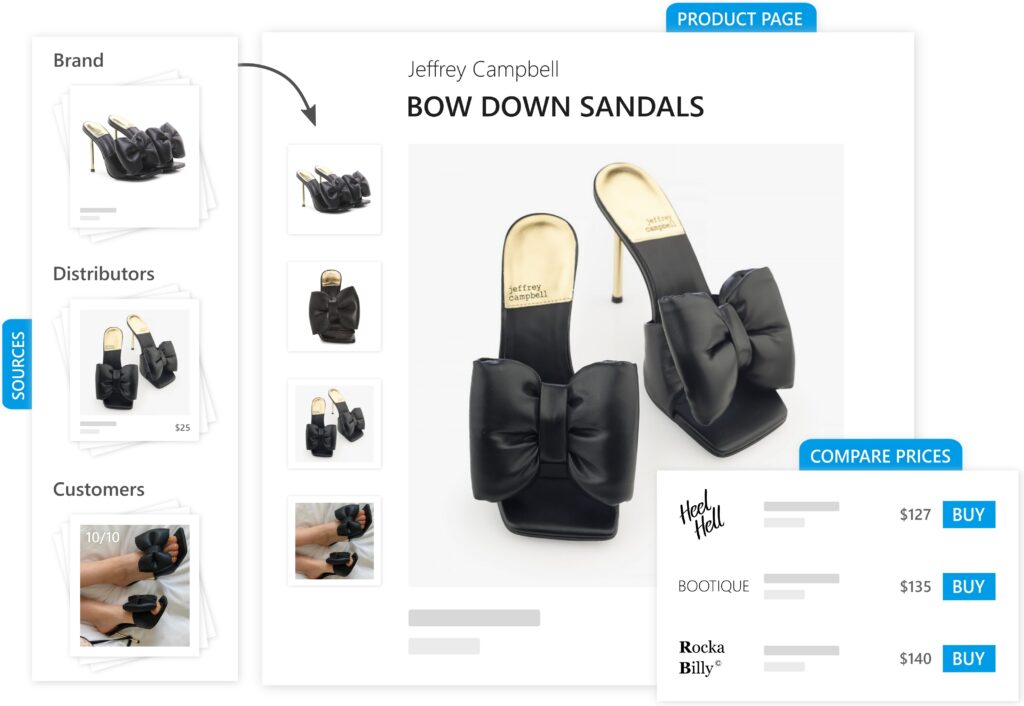
For example, you can showcase all clothing items on models in product listings or display all accessories as standalone photos in the shopping cart. Additionally, you can automate tasks like removing duplicates and sorting user-generated visual content, saving a lot of valuable time. Moreover, AI can be used to quickly spot inappropriate and harmful content.
Provide Relevant Suggestions & Reverse Image Search
During your collection synchronisation, visual search processes each image and each product in it individually. It precisely analyzes various visual features, such as colours, patterns, edges and other structures. Apart from the inventory curation, this will enable you to:
- Have your custom fashion recommendation system. You can provide relevant suggestions from your inventory anywhere across the customer journey from the start page to the kart.
- Improve your website or app with a reverse image search tool. Your visitors can search with smartphone photos, product images, pictures from Pinterest, Instagram, screenshots, or even video content.
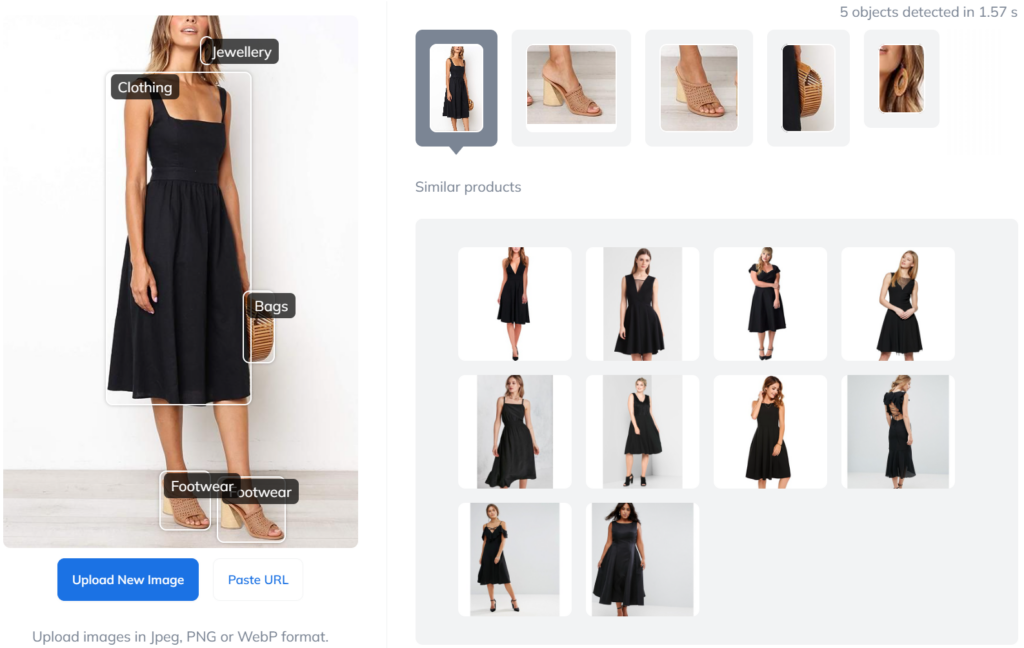
Since fashion detection, image tagging and visual search are the holy trinity of fashion discovery systems, we’ve integrated them into a single service called Fashion Search. Check out my article Everything You Need to Know About Fashion Search to learn more.
Visual search can match images, independent of their origin (e.g., professional images vs. user-generated content), quality and format. We can customize it to fit your collection, even for vintage pieces, or niche fashion brands. For a firsthand experience of how basic fashion visual search operates, check out our free demo.
How Does the Automated Fashion Tagging Work?
Let’s take a closer look at the basic AI-driven tool for the fashion industry: automated fashion tagging. Our product tagging is powered by a complex hierarchy of computer vision models, that work together to detect and recognize all fashion products in an image. Then, each product gets one category (e.g., Clothing), one or more subcategories (e.g., Evening dresses or Cocktail dresses), and a varied set of product tags.
To name a few, fashion tags describe the garment’s type, cut, fit, colours, material, or patterns. For shoes, there are features such as heels, toes, materials, and soles. Other categories are for instance jewellery, watches, and accessories.

The fashion taxonomy encompasses hundreds of product tags for all typical categories of fashion apparel and accessories. Nevertheless, we continually update the system to keep up with emerging trends in the fashion industry. Custom product tags, personal additions, taxonomy mapping, and languages other than the default English are also welcomed and supported. The service is available online – via API.
How Do I Use the Automated Fashion Tagging API?
You can seamlessly integrate automated fashion tagging into basically any website, store, system, or application via REST API. I’d suggest taking these steps first:
First, log into Ximilar App – After you register into Ximilar App, you will get the unique API authentication token that will serve for your private connection. The App has many useful functions, which are summarised here. In the past, I wrote this short overview that could be helpful when navigating the App for the first time.
If you’d like to try creating and training your own additional machine learning models without coding, you can also use Ximilar App to approach our computer vision platform.
Secondly, select your plan – Use the API credit consumption calculator to estimate your credit consumption and optimise your monthly supply. This ensures your credit consumption aligns with the actual traffic on your website or app, maximizing efficiency.

And finally, connect to API – The connection process is described step by step in our API documentation. For a quick start, I suggest checking out First Steps, Authentication & Image Data. Automated Fashion Tagging has dedicated documentation as well. However, don’t hesitate to reach out anytime for guidance.
Do You Need Help With the Setup?
Our computer vision specialists are ready to assist you with even the most challenging tasks. We also welcome all suggestions and custom inquiries to ensure our solutions meet your unique needs. And if you require a custom solution, our team of developers is happy to help.
We also offer personalized demos on your data before the deployment, and can even provide dedicated server options or set up offline solutions. Reach out to us via live chat for immediate assistance and our team will guide you through the entire process. Alternatively, you can contact us via our contact page, and we will get back to you promptly.
Tags & Themes
Related Articles

How to Automate Pricing of Cards & Comics via API
A step-by-step guide on how to easily get pricing data for databases of collectibles, such as comic books, manga, trading card games & sports cards.

Getting Started with Ximilar App: Plan Setup & API Access
Ximilar App is a way to access computer vision solutions without coding and to gain your own authentication key to use them via API.
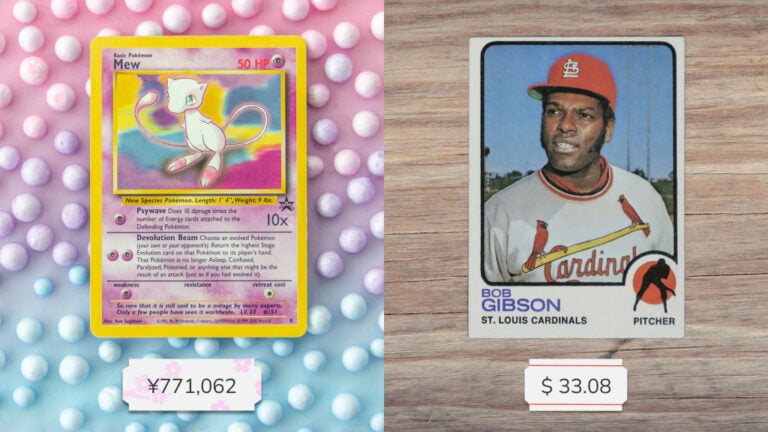
Get an AI-Powered Trading Card Price Checker via API
Our AI price guide can be used for value tracking of cards and comic books, offering accurate pricing data and their history.
